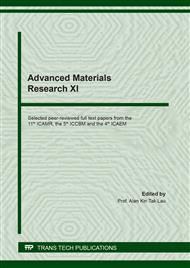p.3
p.13
p.21
p.31
p.39
p.45
p.51
p.61
p.67
Influence Study of the Plastic Deformation Mode on the Micro-Indentation Mechanical Properties for the Pure Molybdenum
Abstract:
Four different plastic deformation modes of pure molybdenum in powder metallurgy were studied, including single tensile, single torsion, tensile-torsion and compressive-torsion. Then the influence of these four plastic deformation modes on the micro-mechanical properties of pure molybdenum in powder metallurgy was studied by the micro-indentation method. The results show that the accumulated strain before deformation instability or fracture of the studied material caused by different plastic deformation modes is different, while showing a regular variation. And the mean indentation hardness along the radial direction of the sample also change regularly, which results in different strengthening effects on the molybdenum material itself. The damage inside the deformed material will cause the apparent modulus of elasticity measured by micro-indentation to decrease significantly.
Info:
Periodical:
Pages:
39-43
Citation:
Online since:
July 2021
Authors:
Price:
Сopyright:
© 2021 Trans Tech Publications Ltd. All Rights Reserved
Share:
Citation:


